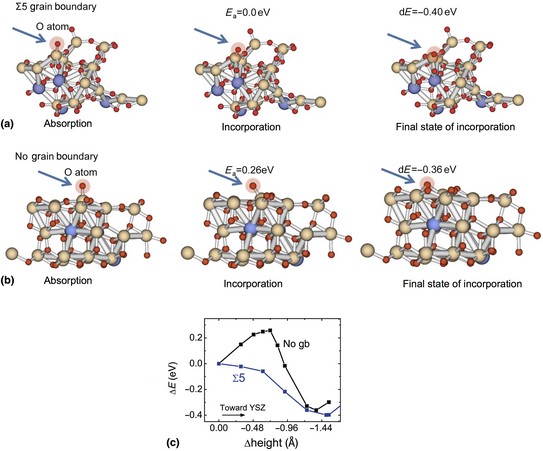Crossref Citations
This article has been cited by the following publications. This list is generated based on data provided by
Crossref.
Bae, Jiwoong
Hong, Soonwook
Koo, Bongjun
An, Jihwan
Prinz, Fritz B.
and
Kim, Young-Beom
2014.
Influence of the grain size of samaria-doped ceria cathodic interlayer for enhanced surface oxygen kinetics of low-temperature solid oxide fuel cell.
Journal of the European Ceramic Society,
Vol. 34,
Issue. 15,
p.
3763.
Lee, Kang Taek
and
Wachsman, Eric D.
2014.
Role of nanostructures on SOFC performance at reduced temperatures.
MRS Bulletin,
Vol. 39,
Issue. 9,
p.
783.
Develos-Bagarinao, Katherine
Kishimoto, Haruo
Yamaji, Katsuhiko
Horita, Teruhisa
and
Yokokawa, Harumi
2015.
Evidence for enhanced oxygen surface exchange reaction in nanostructured Gd2O3-doped CeO2 films.
Nanotechnology,
Vol. 26,
Issue. 21,
p.
215401.
An, Jihwan
Bae, Jiwoong
Hong, Soonwook
Koo, Bongjun
Kim, Young-Beom
Gür, Turgut M.
and
Prinz, Fritz B.
2015.
Grain boundary blocking of ionic conductivity in nanocrystalline yttria-doped ceria thin films.
Scripta Materialia,
Vol. 104,
Issue. ,
p.
45.
Ji, Sanghoon
Tanveer, Waqas Hassan
Yu, Wonjong
Kang, Sungmin
Cho, Gu Young
Kim, Sung Han
An, Jihwan
and
Cha, Suk Won
2015.
Surface engineering of nanoporous substrate for solid oxide fuel cells with atomic layer-deposited electrolyte.
Beilstein Journal of Nanotechnology,
Vol. 6,
Issue. ,
p.
1805.
Park, Joong Sun
An, Jihwan
Lee, Min Hwan
Prinz, Fritz B.
and
Lee, Wonyoung
2015.
Effects of surface chemistry and microstructure of electrolyte on oxygen reduction kinetics of solid oxide fuel cells.
Journal of Power Sources,
Vol. 295,
Issue. ,
p.
74.
Tanveer, Waqas Hassan
Ji, Sanghoon
Yu, Wonjong
and
Cha, Suk Won
2015.
Characterization of atomic layer deposited and sputtered yttria-stabilized-zirconia thin films for low-temperature solid oxide fuel cells.
International Journal of Precision Engineering and Manufacturing,
Vol. 16,
Issue. 10,
p.
2229.
Kim, Jun Woo
Jang, Dong Young
Kim, Manjin
Choi, Hyung Jong
and
Shim, Joon Hyung
2016.
Nano-granulization of gadolinia-doped ceria electrolyte surface by aerosol-assisted chemical vapor deposition for low-temperature solid oxide fuel cells.
Journal of Power Sources,
Vol. 301,
Issue. ,
p.
72.
Feng, Bin
Sugiyama, Issei
Hojo, Hajime
Ohta, Hiromichi
Shibata, Naoya
and
Ikuhara, Yuichi
2016.
Atomic structures and oxygen dynamics of CeO2 grain boundaries.
Scientific Reports,
Vol. 6,
Issue. 1,
Bae, Jiwoong
Yang, Hwichul
Son, Jonghyun
Koo, Bongjun
Kim, Young‐Beom
and
Koc, R.
2016.
Enhanced Oxygen Reduction Reaction in Nanocrystalline Surface of Samaria‐Doped Ceria via Randomly Distributed Dopants.
Journal of the American Ceramic Society,
Vol. 99,
Issue. 12,
p.
4050.
Kim, Ji-Su
and
Kim, Yeong-Cheol
2017.
Proton conduction across and along BaO– and ZrO2–terminated (001) BaZrO3 surfaces using density functional theory.
Solid State Ionics,
Vol. 306,
Issue. ,
p.
137.
Shin, Jeong Woo
Go, Dohyun
Kye, Seung Hyeon
Lee, Sungje
and
An, Jihwan
2019.
Review on process-microstructure-performance relationship in ALD-engineered SOFCs.
Journal of Physics: Energy,
Vol. 1,
Issue. 4,
p.
042002.
Kim, Seo Ju
Choi, Mingi
Lee, Jongseo
and
Lee, Wonyoung
2020.
Modifying defect structures at interfaces for high-performance solid oxide fuel cells.
Journal of the European Ceramic Society,
Vol. 40,
Issue. 8,
p.
3089.
Ji, SangHoon
and
Kim, WeonJae
2022.
Is Coating Oxide on Porous Metal Thin-Film for Low-Temperature Solid Oxide Fuel Cell Cathode a Panacea for Performance Enhancement?.
International Journal of Precision Engineering and Manufacturing,
Vol. 23,
Issue. 4,
p.
445.
Yang, Gene
Nam, Sang-Hoon
Han, Gina
Fang, Nicholas X.
and
Lee, Dongkyu
2023.
Achieving Fast Oxygen Reduction on Oxide Electrodes by Creating 3D Multiscale Micro-Nano Structures for Low-Temperature Solid Oxide Fuel Cells.
ACS Applied Materials & Interfaces,
Vol. 15,
Issue. 43,
p.
50427.
